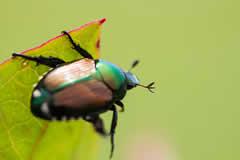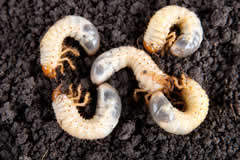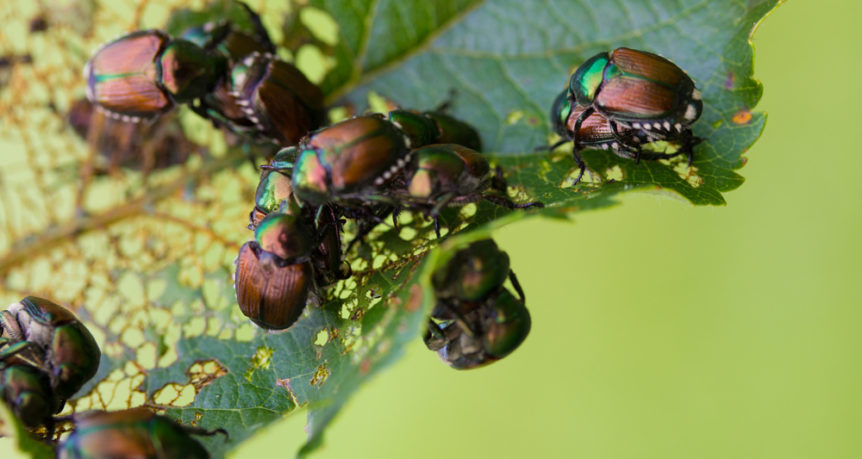Japanese Beetles are a fairly common pest throughout the midwest and eastern United States. And Milwaukee and SE Wisconsin bring the bug’s ideal temperature and humidity levels in June-August so they run rampant around here! So here is some info on these aggressive little pests along with tips for getting rid of Japanese Beetles in Milwaukee & SE Wisconsin…
Have a Pro Take a Look
Contact our team for a free estimate on your Japanese Beetle problems. We can get rid of these little troublemakers for you!
Free EstimateHow to Identify Japanese Beetles
Adults:
 Although some view the Japanese beetle as a beauty with it’s shimmering exoskeleton, many gardeners find these pests to be total beasts. Adult Japanese Beetles boast dark green metallic heads, metallic amber or bronze wings, and several tufts of white hair. Two white paint brush shaped tufts appear on the rear of the beetle as well as 5 additional white tufts on each side of the beetle. They’re about 3/8″ long and 1/4″ wide.
Although some view the Japanese beetle as a beauty with it’s shimmering exoskeleton, many gardeners find these pests to be total beasts. Adult Japanese Beetles boast dark green metallic heads, metallic amber or bronze wings, and several tufts of white hair. Two white paint brush shaped tufts appear on the rear of the beetle as well as 5 additional white tufts on each side of the beetle. They’re about 3/8″ long and 1/4″ wide.
Adult Japanese Beetles leave behind the dark moist soil of their youth and venture up in the world to munch on a variety of plants. While rosebuds or other flowers can be found eaten from the inside out, most adult Japanese beetles specialize in a unique style of tree defoliation.The beetle’s favorite foods are Rose bushes, Norway Maple, Linden, Crabapple, Japanese Maple, Crape Myrtle, Pin Oak, Birch, Apple, and Cherry.
Grubs:
 Baby Japanese beetles, or grubs, have a vastly different appearance than their mature parents. Japanese beetle grubs are white “C” shaped caterpillar like bugs with amber heads.
Baby Japanese beetles, or grubs, have a vastly different appearance than their mature parents. Japanese beetle grubs are white “C” shaped caterpillar like bugs with amber heads.
Japanese beetle grubs are usually found in the soil feeding on grass roots, but have also been found in the soil of vegetable gardens feeding on the roots of corn, beans, tomatoes, and strawberries.
Where You’ll Spot Japanese Beetles
Japanese beetles only eat the soft tissue of leaves leaving the veins of the plant intact. This technique creates a strange skeleton of the leaf that somewhat resembles lace – so it’s hard to miss. Be sure to check their favorite foods listed above to see if there are signs of their presence.
Due to the grub’s fondness for grass roots, dead brown patches of grass are a pretty clear indicator that they are lurking at the surface. Unfortunately other ground pests, such as burrowing rodents, can cause additional damage in their hunt for these grubs. So there is even more reason to address these pests before they contribute to massive lawn damage.
How to Get Rid of Japanese Beetles
There are some pesticides for both Japanese beetles and their grubs. Neem oil, a concentrated oil from the fruits and seeds of the Nimtree, has also been proven to aid in the control of a variety of garden pests. Unfortunately even with these tools your plants may still be at risk.
Are you ready for the most effective way to get rid of these little buggers? Hand pick them off each leaf.
I know. “Ewwwe!”
But if you have the time and gumption, hand picking Japanese Beetles off your plants and killing each one is the absolute best way to make sure they are gone for good. If you choose this method, we suggest plucking them from your plants and putting them in a bucket with liquid dishwashing detergent and water to do the dirty deed of killing them.
If you don’t have the time, patience or stomach for handpicking beetles and sending them to a bubbly death, there are also retail products you can use to spray your plants. However, they are not super effective and the beetles can quickly return.
Truthfully, there is no better way to keep your plants safe and healthy than to use a skilled arborist and accredited professional like M&M Tree Care. Since 1968 our expert staff has assisted business owners and home owners in SE Wisconsin to keep their trees, shrubs and plants healthy and happy.
For more information on insect treatments and other services provided by M&M Tree Care, please contact us.
Share this Post

